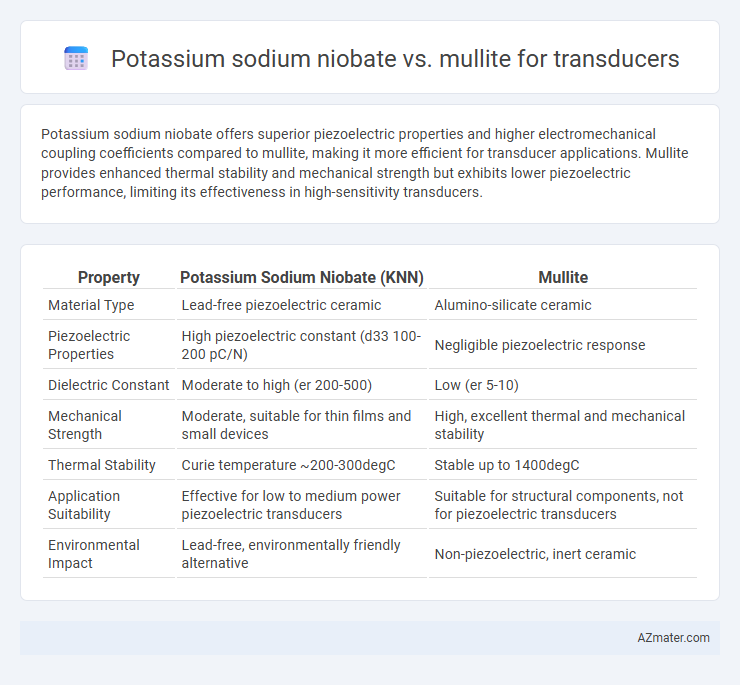Potassium sodium niobate offers superior piezoelectric properties and higher electromechanical coupling coefficients compared to mullite, making it more efficient for transducer applications. Mullite provides enhanced thermal stability and mechanical strength but exhibits lower piezoelectric performance, limiting its effectiveness in high-sensitivity transducers.
Table of Comparison
| Property | Potassium Sodium Niobate (KNN) | Mullite |
|---|---|---|
| Material Type | Lead-free piezoelectric ceramic | Alumino-silicate ceramic |
| Piezoelectric Properties | High piezoelectric constant (d33 100-200 pC/N) | Negligible piezoelectric response |
| Dielectric Constant | Moderate to high (er 200-500) | Low (er 5-10) |
| Mechanical Strength | Moderate, suitable for thin films and small devices | High, excellent thermal and mechanical stability |
| Thermal Stability | Curie temperature ~200-300degC | Stable up to 1400degC |
| Application Suitability | Effective for low to medium power piezoelectric transducers | Suitable for structural components, not for piezoelectric transducers |
| Environmental Impact | Lead-free, environmentally friendly alternative | Non-piezoelectric, inert ceramic |
Introduction to Transducer Materials
Potassium sodium niobate is a lead-free piezoelectric material known for its high electromechanical coupling coefficients and environmental safety, making it a strong candidate for advanced transducers. Mullite, a stable aluminosilicate ceramic, offers excellent mechanical strength and thermal stability but lacks inherent piezoelectric properties, limiting its role mainly to structural components in transducer assemblies. Potassium sodium niobate's superior piezoelectric response contrasts with mullite's robustness, highlighting a trade-off between functional performance and material durability in transducer design.
Overview of Potassium Sodium Niobate (KNN)
Potassium sodium niobate (KNN) is a lead-free piezoelectric ceramic known for its high electromechanical coupling coefficient and environmental friendliness, making it a promising material for transducer applications. KNN exhibits strong ferroelectric properties, high Curie temperature (~420degC), and good mechanical stability, which enhance its performance under thermal and electrical stress compared to traditional materials like mullite. Unlike mullite, which is primarily valued for thermal insulation and mechanical strength, KNN's superior piezoelectric response enables more efficient energy conversion in sensors and actuators.
Mullite: Composition and Properties
Mullite, primarily composed of 3Al2O3*2SiO2, exhibits exceptional thermal stability, low dielectric loss, and high mechanical strength, making it an ideal piezoelectric transducer substrate. Its intrinsic tolerance to high temperatures and chemical inertness surpass potassium sodium niobate, enabling reliable performance in harsh environments. These properties contribute to Mullite's superior durability and consistent transduction efficiency in aerospace and industrial sensor applications.
Material Structure Comparison: KNN vs Mullite
Potassium sodium niobate (KNN) boasts a perovskite crystal structure characterized by a tetragonal lattice, enabling superior piezoelectric and ferroelectric properties essential for high-performance transducers. Mullite, with an orthorhombic crystal system and complex aluminosilicate composition, offers excellent thermal and mechanical stability but lacks the intrinsic piezoelectric response present in KNN. The distinct difference in crystal symmetry and ionic bonding between KNN and mullite fundamentally impacts their suitability, with KNN's structure optimizing electromechanical coupling versus mullite's focus on structural durability.
Dielectric and Piezoelectric Properties Analysis
Potassium sodium niobate (KNN) exhibits superior piezoelectric coefficients (d33 ~ 100-200 pC/N) and high dielectric constant (er ~ 500-1000), making it highly efficient for transducer applications. Mullite, with a lower dielectric constant (er ~ 10-20) and negligible piezoelectric response, primarily serves as a substrate material rather than an active piezoelectric element. The strong ferroelectric behavior and lead-free composition of KNN provide an environmentally friendly alternative with enhanced sensitivity and stability compared to mullite in piezoelectric transducer design.
Thermal Stability in Transducer Applications
Potassium sodium niobate (KNN) exhibits superior thermal stability compared to mullite in transducer applications, maintaining consistent piezoelectric properties at elevated temperatures up to 400degC. Mullite, with its high melting point around 1840degC, offers excellent thermal shock resistance but suffers from lower piezoelectric performance and reduced sensitivity at high temperatures. KNN's enhanced thermal stability and environmentally friendly composition make it the preferred choice for high-temperature transducers in harsh industrial environments.
Mechanical Strength and Durability Assessment
Potassium sodium niobate (KNN) exhibits superior mechanical strength and piezoelectric properties compared to mullite, making it highly suitable for transducers requiring high sensitivity and stability. KNN's enhanced fracture toughness and resistance to mechanical fatigue contribute to its durability under cyclic loading, outperforming mullite's relatively brittle nature. Mullite, while thermally stable, lacks the intrinsic piezoelectric capabilities and mechanical robustness essential for long-term, high-performance transducer applications.
Environmental and Toxicological Considerations
Potassium sodium niobate (KNN) offers a lead-free, environmentally friendly alternative to traditional piezoelectric materials like mullite, which contains toxic elements and poses disposal challenges. KNN demonstrates lower ecological impact due to reduced hazardous waste generation and improved biocompatibility, making it suitable for sustainable transducer applications. Mullite, while stable, may release harmful compounds over time, increasing environmental contamination risks and complicating waste management in electronic device manufacturing.
Performance in High-Frequency Transducers
Potassium sodium niobate (KNN) demonstrates superior piezoelectric sensitivity and electromechanical coupling coefficients compared to mullite, making it highly effective for high-frequency transducer applications. Its lead-free composition and enhanced dielectric properties contribute to stable performance with low dielectric loss at frequencies above 1 MHz. Mullite exhibits excellent thermal stability but lower piezoelectric efficiency, limiting its effectiveness in high-precision, high-frequency ultrasonic devices.
Future Trends and Selection Criteria
Potassium sodium niobate (KNN) demonstrates superior piezoelectric properties, environmental friendliness, and lead-free composition compared to traditional Mullite, making it a promising candidate for next-generation transducers. Future trends emphasize integrating KNN in miniaturized, high-frequency transducers due to its enhanced electromechanical coupling and temperature stability. Selection criteria increasingly prioritize biocompatibility, tunable dielectric properties, and scalability, favoring KNN over Mullite for advanced ultrasonic and sensor applications.

Infographic: Potassium sodium niobate vs Mullite for Transducer
 azmater.com
azmater.com